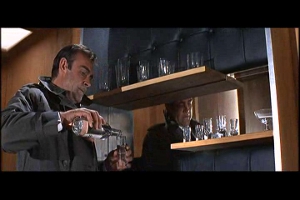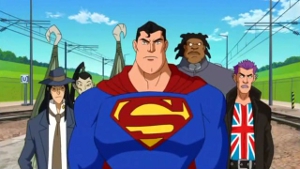Category Archives: Movies
Live and Let Die (1973)
First, a salute to Baron Samedi:


Great Tracy’s ghost, it’s finally here! The debut of Roger Moore, the Third and Longest-Lasting Bond (so far), who’ll carry the weight of these next seven films for a very long time. I feel like a kid at Christmas because the Moore Era contains some of the series best and worst, irrevocably cementing Bond’s place in modern cinema as a character who’d outlive his actors….for better and worse…
Where Connery feared the role would dominate his career, Moore came to it already “groomed” by eight years as TV’s The Saint. He seemed to embrace that….despite having to cut his hair and loose some weight for this part. He’d packed it on and let it grow out during his disastrous slow-motion train wreck of a TV show The Persuaders! (Yes, the exclamation point’s part of the title – whaddya expect? It was the 70s.) At that point, Moore could’ve helmed ten bad TV shows and people still would’ve flocked to their theaters to see him as James Bond in (a heavily altered facsimile of) Ian Fleming’s Live and Let Die. Continue reading Live and Let Die (1973)
Diamonds Are Forever (1971)

Never say never. Connery shouted it from every rooftop he could find during and after the production of You Only Live Twice. When Eon came begging him back he took a page from SPECTRE’s playbook and extorted the largest amount of money anyone had ever received for a lead role up to that time, officially beginning our modern Lead Actor Salary Arms Race. The number 1.25 million is thrown around a lot in the attendant literature, though I’ve heard conflicting reports as to whether that’s in pounds or dollars.
Either way, it was a healthy chunk of change at a time of worldwide economic upheival. Connery, to his credit, used that cash to establish The Scottish International Education Trust, which still puts money in the hands of artistic Scots to this very day. He also got United Artists to back his friend Sidney Lumet’s movie The Offense, which everyone should go out and see. It’s unquestionably better than Diamonds Are Forever. Continue reading Diamonds Are Forever (1971)
The Amazing Spider-Man (2012)
On Her Majesty’s Secret Service (1969)

Like I said,
To this day I wish Connery had stuck around for one last swan song. Bond fans could’ve avoided a whole lot of heartache…
But then again, maybe not. I like Connery, but not the bored, sick-of-it-all self-parody he became by the time he filmed You Only Live Twice. So I might as well confess: I’m one of those people who actually like On Her Majesty’s Secret Service. I won’t dare call it “the best Bond film ev-ahr” when we’ve still got sixteen of these damned things to go…but I will stick my neck out far enough to call it the best film since Goldfinger. Halfway through, I guessed they had to work through two films worth of same-y-feeling crap before anything good escaped the pipeline.
Turns out that’s truer than I’d like it to be. OHMSS (as it’s reverently known) was originally meant to follow Goldfinger. Returning series screenwriter Richard Maibaum stated pecking out the script, an adaption of Fleming’s tenth Bond novel, while the film rights to Thunderball were still up in the judicial air. After Thunderball hit, the warm Swiss summer of 1966 made most of OHMSS’ Big Ticket action sequences prohibitively expensive (if not outright life-threatening). Production relocated to Japan and re-purposed everything for You Only Live Twice. When that did even better than Thunderball, OHMSS finally saw daylight…after a two-year search for the Next James Bond. Continue reading On Her Majesty’s Secret Service (1969)
The Incredible Hulk (1977)
You Only Live Twice (1967)

And now we get to talk about Sequelitis. You’d expect the fifth Bond movie to bear some resemblance to its predecessors, but You Only Live Twice can’t seem to help calling attention to its heritage. Personally, I blame Roald Dahl. He should’ve turned this project down from the start. He and Ian Fleming were apparently good friends in real life, but their writing styles couldn’t be further from each other if you placed them on opposites sides of the cosmos. Dahl hated the novel that shares this film’s title and, twenty-one years after the film premiered, flat-out admitted to Starlog magazine “I didn’t know what the hell Bond was going to do.” Producers Albert Broccoli and Harry Saltzman answered by giving him The Formula, whole and (more or less) complete by 1966, at the latest.
As Dahl defined The Formula would go on to define this series:
“Bond has three women through the film: If I remember rightly, the first gets killed, the second gets killed and the third gets a fond embrace during the closing sequence. And that’s the formula. They found it’s cast-iron. So, you have to kill two of them off after he has screwed them a few times. And there is great emphasis on funny gadgets and love-making.”
With this information, the author of Charlie and the Chocolate Factory became the author what is essentially Dr. No 2: In Japan. You can tell how many people actually bother to read Dahl’s work by whether or not they call this film “silly.” Sorry, Charlie, but compared to The Chocolate Factory (published the same year as this film’s eponymous novel) and especially compared to The Glass Elevator, this is Roald Dahl phoning it in after he’s taken a fist-full of horse tranquilizers. And he still managed to create one of the most influential films of the series, large portions of which have become fertile ground for parody, satire and knowing reference. So I come not to bury this fifth Bond film, but to lament what could have been…and argue that, as “silly” as things get in this picture, they could’ve stood to get a whole lot “sillier.” There might be more to recommend. Continue reading You Only Live Twice (1967)
Superman vs. The Elite (2012)

Whenever I get sick of dealing with live action superhero films and the all-but-inevitable disappointment that entails, I look to animation and shout, “Save me.” Specifically Warner Brothers, who’ve looked down and whispered “No,” more times than not. That’s what happens when the marking department dictates what we’ll get, and when. Given there’s a new (live action) Superman movie in production at the time of this writing, here comes the latest animated one, Superman vs. The Elite. Will it rescue us from the crushing mediocrity of things like Justice League: Doom or Batman: Year One? Or will it become what it hates in the name of The Greater Good?
Oh hell, you guys know me, I can’t keep a secret. Not only is it better than Doom and Year One, it’s the second best piece of Superman animation we’ve seen since the cancellation of his last cartoon series…the first being All-Star Superman, of course.
Not that you could tell from the fan reactions. The happy few who stoop to view animated features might be shocked to learn this, but some of my fellow Superfans found All-Star wanting. Few outright hate it, but it’s still a too-short adaption of an twelve issue miniseries, large chunks of which were excised to fit the marketing-mandated 76-minute run time. If you want to “premiere” your film on the Cartoon Network, seventy-six minutes is the perfect length. But as I’ve been saying for five damn years (at this point) arbitrary length restrictions won’t make your film any better. If the WB wanted to do that they’d tell Cartoon Network’s ad-buyers to fuck themselves and make something feature length. It’s not the 40s anymore, guys. You can have a Third Act that isn’t rushed. Continue reading Superman vs. The Elite (2012)
Thunderball (1965)
“Well…can’t win them all.”

Way back in my Halloween 4 review I half-joked that, in the vast multiverse of franchise films, only Star Trek and Godzilla have managed to field strong fourth entries. I was immediately “well, actually”-ed by friend of the site David Lee Ingersoll‘s contention that Thunderball “isn’t bad.” Shopping this critique around, I realized Thunderball divides quite a few Bond fans…though nowhere near as much as some Roger Moore movies I could, and will eventually, mention.
I should’ve expected this. Now that we’re on Film Number Four, we can see the full scope of Bond’s world. From this point on, we’ll have plenty of time to consider all its wonderfully disparate elements and decide which we’d prefer to see…as opposed to what we’re actually watching. Because what we’re watching will increasingly serve to remind us of other, better, James Bond films. And why shouldn’t it? Goldfinger made a ton of money, so why not give the people more of that? Making this film knowing in their guts that it would be a hit must’ve felt like a license to supply heroin to William S. Burroughs. Especially since the bones of this script were already four years old by the time cameras rolled. Continue reading Thunderball (1965)
